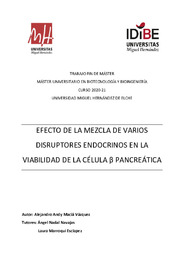Por favor, use este identificador para citar o enlazar este ítem:
https://hdl.handle.net/11000/25756Registro completo de metadatos
| Campo DC | Valor | Lengua/Idioma |
|---|---|---|
| dc.contributor.advisor | Nadal Navajas, Ángel | - |
| dc.contributor.advisor | Marroquí Esclapez, Laura | - |
| dc.contributor.author | Maciá Vázquez, Alejandro Andy | - |
| dc.contributor.other | Departamentos de la UMH::Fisiología | es_ES |
| dc.date.accessioned | 2022-01-27T08:53:58Z | - |
| dc.date.available | 2022-01-27T08:53:58Z | - |
| dc.date.created | 2021-06-30 | - |
| dc.identifier.uri | http://hdl.handle.net/11000/25756 | - |
| dc.description.abstract | El sistema endocrino controla numerosos procesos fisiológicos y de homeostasis. En nuestro día a día nos exponemos a multitud de sustancias químicas exógenas y algunas de ellas, conocidas como disruptores endocrinos, son capaces de interactuar con el sistema endocrino y producir efectos adversos sobre el organismo de un individuo o su progenie. En los últimos años, estudios en modelos celulares y animales, así como, estudios epidemiológicos en humanos, sugieren que los disruptores endocrinos podrían ser un factor importante en el desarrollo de la diabetes mellitus, una de las enfermedades más prevalentes en la actualidad. A pesar de este avance en el conocimiento entre la exposición a disruptores endocrinos y la diabetes, son pocos los trabajos que se centran en el estudio de los efectos de la exposición de varias de estas sustancias al mismo tiempo; tal como ocurre en nuestra vida cotidiana. En este trabajo estudiamos los efectos en la viabilidad celular de las células β pancreáticas al exponerlas a una mezcla entre tres importantes disruptores endocrinos, como son el Bisfenol A, presente en numerosos envases de comida y bebida que consumimos habitualmente, el Tributilestaño, un potente biocida bioacumulado en numerosas especies acuáticas que forman parte de nuestra dieta, y el Triclosán, presente en muchos de nuestros productos de higiene que usamos a diario. Con ello queremos determinar posibles efectos sinérgicos o aditivos entre ellos que puedan estar consecuentemente afectando al desarrollo de la diabetes. Para lograr estos objetivos empleamos la línea celular INS-1E, formada a partir de células β de insulinoma de rata, a las cuales tratamos con los diferentes disruptores endocrinos durante 72 horas antes comprobar la viabilidad celular mediante el ensayo de MTT. Los resultados evidenciaron tanto en la mezcla con Bisfenol A y Tributilestaño, como de Bisfenol A con Triclosán, que no existe ningún tipo de sinergia, aditividad o antagonismo entre ellas. | es_ES |
| dc.description.abstract | The endocrine system controls numerous physiological and homeostasis processes. in our daily life we are exposed to a multitude of exogenous chemical substances and some of them, which are known as endocrine disruptors, are able to interact with the endocrine system and producing adverse effects on the organism of an individual or his progeny. In recent years, studies in cellular and animal models, as well as epidemiological studies in humans, suggest that endocrine disruptors could be an important factor in the development of diabetes mellitus, one of the most prevalent diseases nowadays. Despite this advance in THE knowledge between exposure to endocrine disruptors and diabetes, there’s only a small number of studies that focus on the effects to the exposure to several of these substances at the same time; just as it happens in our daily lives. In this work we studied the effects on cell viability of pancreatic β cells by exposing them to a mixture of three important endocrine disruptors, such as the Bisphenol A, WHICH IS present in many food and drink packages that we usually consume, the Tributyltin, a powerful biocide which is still being bioaccumulated in numerous aquatic species WHICH ARE part of our diet, and THE Triclosan, which is present in many of our hygiene products that we utilize daily. With this we want to determine possible synergistic or additive effects between them that may be consequently affecting the development of diabetes. To achieve these objectives, we used the INS-1E cell line, made up of rat insulinoma β cells, which were treated with the different endocrine disruptors for a duration of 72 hours before checking cell viability using the MTT assay. The results showed in both, the mixture with bisphenol A and Tributyltin, and the one of bisphenol A with Triclosan, that there is no type of synergy, additivity or antagonism between them. | es_ES |
| dc.format | application/pdf | es_ES |
| dc.format.extent | 62 | es_ES |
| dc.language.iso | spa | es_ES |
| dc.publisher | Universidad Miguel Hernández de Elche | es_ES |
| dc.rights | info:eu-repo/semantics/openAccess | es_ES |
| dc.rights | Attribution-NonCommercial-NoDerivatives 4.0 Internacional | * |
| dc.rights.uri | http://creativecommons.org/licenses/by-nc-nd/4.0/ | * |
| dc.subject | disruptores endocrinos | es_ES |
| dc.subject | Célula β | es_ES |
| dc.subject | Viabilidad celular | es_ES |
| dc.subject | Bisfenol A | es_ES |
| dc.subject | Tributilestaño | es_ES |
| dc.subject | Triclosán | es_ES |
| dc.subject.other | CDU::5 - Ciencias puras y naturales::57 - Biología | es_ES |
| dc.title | Efecto de la mezcla de varios disruptores endocrinos en la viabilidad de la célula β pancreática | es_ES |
| dc.type | info:eu-repo/semantics/masterThesis | es_ES |

Ver/Abrir:
198 MACIA VAZQUEZ, ALEJANDRO ANDY-Memoria TFM.pdf
2,09 MB
Adobe PDF
Compartir:
 La licencia se describe como: Atribución-NonComercial-NoDerivada 4.0 Internacional.
La licencia se describe como: Atribución-NonComercial-NoDerivada 4.0 Internacional.
.png)